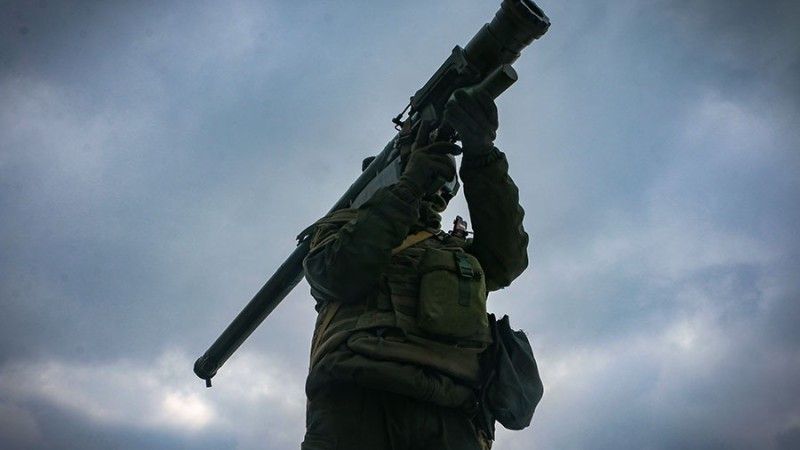Polish Weapons Defending Ukraine [ANALYSIS]

Photo. Ukrainian Armed Forces via Twitter.
According to the officially released information, Poland has become the second most significant arms supplier for the Ukrainian Armed Forces, as the value of the delivered weapons exceeded USD 1.6 bn. now. The above amount does not include the equipment procured at the Polish companies, and equipment coming from the surplus, transferred over the last 8 years. No official information has been released on the topic, at least in Poland. However, the Ukrainian sources, as well as imagery and videos emerging online, allow us to deduce what inventory has been transferred.
According to the officially released information, Poland has become the second most significant arms supplier for the Ukrainian Armed Forces, as the value of the delivered weapons exceeded USD 1.6 bn. now. The above amount does not include the equipment procured at the Polish companies, and equipment coming from the surplus, transferred over the last 8 years. No official information has been released on the topic, at least in Poland. However, the Ukrainian sources, as well as imagery and videos emerging online, allow us to deduce what inventory has been transferred.
The Polish armament in Ukraine can be divided into two separate categories. The first one included modern weapons that have been recently manufactured, domestically, and sent east straight from the production line, or from the Polish Armed Forces' stock. The Polish military would soon receive brand new examples of the very same armament. The second category includes legacy, used, Warsaw Pact equipment - heavy assets that would be incredibly expensive if brand new. To replace that armament, Poland would either procure or receive, more modern weapons of western origin.
Piorun MANPADS
Piorun MANPADS is the best-known weapons system transferred from Poland to Ukraine, apart from the T-72 MBTs. We do not know the number of missiles and launch systems supplied. The system is manufactured by the Polish Mesko company. Until the end of 2021 Poland has taken delivery of 730 missiles and 260 launch units, from the total quantity of 1,300 missiles, and 420 launchers. Ukraine received an undisclosed quantity of those missiles, however, some units of the Ukrainian military (airborne elements, national guard) have already officially reported several kills, involving the Russian Su-25, and Su-34 attack aircraft, or Ka-52 and Mi-24 helicopters. The rumors suggest that the number of Piorun kills in Ukraine has reached double digits. Notably, the high effectiveness of the Piorun missiles in Ukraine results in greater interest in this weapons system around the world. It seems that the Piorun's reputation as the best MANPADS class system has been confirmed - Piorun allows the operator to quickly launch the missile against a low-flying threat which, so far, has been impossible for the competing designs. Now, we do know that Poland is to increase the number of the procured Piorun missiles. The production line is expected to be capable of manufacturing up to 1,000 missiles per year. So far, around 300 missiles were manufactured, annually.
#Russia #Ukraine 🇷🇺🇺🇦: A recent video shows #Ukrainian Combatants using a #Polish PPZR Piorun "Grom-M" MANPADS (supplied by #Poland 🇵🇱 to UAF). pic.twitter.com/qwUzgV0uJ7
— War Noir (@war_noir) May 19, 2022
Grot Rifle
Photographs and movie clips depicting the Ukrainian soldiers equipped or presenting the Polish FB Radom Grot missiles have also been published. The first photograph showing the Polish firearm depicted soldiers of the territorial defence units using the A0 or A1 legacy variant of the rifle. New recordings also feature the modernized guns - most probably the Grot C16A2, with much longer stock. The Ukrainians refer to Grot as modern, handy, NATO carbines - probably praising the design.
#APU soldier displaying one of the #Polish FB Radom MSBS Grot C16A2 assault rifles recently delivered ot #Ukraine.#Ukraine#ukrainianwar#UkraineInvasion pic.twitter.com/TdrrwZU4ey
— Uri Kikaski (@UKikaski) May 11, 2022
RGP-40 Grenade Launchers
The recordings captured in Ukraine also feature the 40 mm RGP-40 multiple grenade launchers. 200 weapons as such have been ordered by the Polish Armed Forces at the ZM Tarnów facility, however, the Polish military has never taken the delivery. It is uncertain whether the factory stock was sent to Ukraine, or whether the depicted examples were among the extra products ordered by Ukraine at the Tarnów facility.
#Russia #Ukraine 🇷🇺🇺🇦: A recent photo of a #Ukrainian combatant —the location was not specified.
— War Noir (@war_noir) May 14, 2022
The combatant appears to be carrying a noteable Polish 40x46mm RGP-40 revolver grenade launcher. These GLs are apparently supplied to Ukrainian Forces by #Poland 🇵🇱 recently. pic.twitter.com/f2a9abpoFq
Warmate and FlyEye UAVs
Back in 2015, the first WB Group FlyEye systems have been delivered to Ukraine - where they have gained a good reputation, and new orders were placed instantly. Due to the high resilience exhibited towards electronic countermeasures, instead of being used in artillery units (still being used in that role anyway), they are often employed by the Ukrainian SOF. Considering the high importance of UAV-guided artillery in this war, the FlyEyes may be among the critical assets here. Despite that, no information on the use of that UAV emerges online.
Soon afterward, Ukraine also received the WB Group's loitering munitions - Warmate. Ukrainians, jointly with the Polish supplier, have begun working on enhancing the levels of interoperability between these two systems. As a result of these works, the Sokol system was rolled out in 2017, consisting of Kozak-2M all-terrain vehicle accommodating the control station, along with UAVs: a single FlyEye, and three Warmate systems. Not only have the Polish systems been exported to Ukraine, but they are also manufactured there. Technologies transferred by the WB Group are also used to design and manufacture proprietary, Ukrainian UAV designs, such as the light reconnaissance Leleka-100 UAV, based on the Warmate design. The WB Group has also been engaged in other joint projects with the Ukrainian industry, including one aimed at the development of an artillery/counter-UAS solution named ZRN-01 "Stokrotka", utilizing 80 mm unguided rockets.
T-72M/M1/M1R
Transfer of the Polish T-72 main battle tanks has been the most broadly commented deed. These MBTs appeared in movie clips depicting the Ukrainian soldiers engaged in training on the T-72 main battle tanks wearing the Polish camouflage scheme. These vehicles had no ERA of any sort. Some, however, had no IR-illuminator and featured a thermal imaging system's window on top of the turret. The observation system upgrades are among the key elements of the T-72M1R upgrade - this refers to the vehicles that underwent a limited-scope upgrade programme implemented by the Polish industry. The T-72M1R MBTs received the KLW-1 Asteria thermal imaging system, along with a passive set of observation instruments for the commander, and the gunner. The MBTs received by the Polish Armed Forces also featured a digital intercom/external communications suite by WB Group, a new navigation system, and other, minor upgrades.
#Ukraine: As expected, tanks donated by Poland to Ukraine received additional ERA protection- here we see a Polish T-72M1R covered with Kontakt-1 blocks.
— 🇺🇦 Ukraine Weapons Tracker (@UAWeapons) May 18, 2022
T-72M1R tanks are quite capable, having been upgraded with KLW-1 "Asteria" gunner thermal vision and modern communications. pic.twitter.com/qaPaHe6gLQ
According to the PLN 1.749 billion agreement signed back in 2019 by a consortium formed by PGZ Group, ZM Bumar-Łabędy, and WZM Poznań, 230 MBTs were to be upgraded as a baseline, with 88 examples envisaged within the right of option. This is probably why information is circulated suggesting that Poland has transferred 230 MBTs to Ukraine - the estimated number is, however, between 150 and 200. However, the aforesaid number probably did not undergo all of the aforelisted upgrades. It is possible that some of the transferred MBTs came in a form of ordinary T-72M/M1s. Recordings are circulated around the Internet, with the Ukrainian soldiers engaged in training on the Polish MBTs, along with a photograph of an MBT wearing the captured Russian ERA.
BWP-1 Vehicles and Artillery
Some information suggests that Poland has also provided Ukraine with minor quantities of BWP-1 IFVs, 2S1 Gvozdika self-propelled howitzers, and BM-21 rocket launchers. For BWP-1, 40 examples were mentioned, along with more than 20 artillery pieces. This piece of information is hard to verify. Nonetheless, it would refer to the trace quantities of the oldest inventory of the Polish military. That equipment would have been decommissioned anyway, as new replacement systems are expected to be received soon: Borsuk IFVs, Krab sph, and HIMARS systems.
Armoured Vehicles
Polish Dzik-2 armoured cars also appeared in Ukraine. It cannot be ruled out that these had been procured by Ukraine before the Russian Invasion started on 27th February 2022. These have been withdrawn back in 2014 (Military Police operated 43 examples in total). These were available through the Military Property Agency, and the Donbas war was already underway. The fact that the Dziks photographed in Ukraine today wear the Ukrainian pixel camo scheme may suggest that they had been used in the Ukrainian Army beforehand.
Polish armored car AMZ "Dzik-2". pic.twitter.com/7y7SWCq8oe
— ТРУХА⚡️English (@TpyxaNews) May 17, 2022
Ammunition
Poland has also delivered an unspecified quantity of munitions, coming from the surplus stock. No details are available here. This may refer to old munitions that would become outdated anyway, and that are compliant with weapons systems that are soon to be withdrawn. This may refer to 125 mm tank ammunition (obsolete rounds, but the more, the merrier), 122 mm 2S1 Gvozdika rounds, 122 mm BM-21 rockets, or 80 mm unguided rockets for the attack aircraft. 12.7 mm, 7.62 mm, and 5.56 mm rifle rounds, or 23 mm AAA ammunition could also have been delivered.
Komar RPGs
The emergence of the old, 40 mm single-use RPG-76 Komar grenade launchers in Ukraine has been an interesting development. 100,000 were made, between 1983 and 1995. This system was decommissioned in the late 1990s, as it did not meet the western safety standards, and also had no self-destruction system embedded. Despite that, the Polish military used to utilize this system abroad, justifying that by an urgent operational requirement. Back in 2018, the Military Property Agency still had 25 thousand examples on sale. How many were given to Ukraine remains unclear, nonetheless, Komar is often portrayed in videos involving the Ukrainian soldiers. This weapon is not lethal when used against heavy armor, but it may be useful against lighter armour, logistical assets, or infantry.
Another gift from NATO; UA forces training with newly delivered RPG-76 Komar single-use RPG, made in Poland in great quantities during the Cold War
— TomthunkitsMind (@VippusaO) May 12, 2022
Though these aren't very effective against modern Russian MBT, they would still work against structures.pic.twitter.com/WGhlUn2zi9 03
Air-to-Air Missiles and the Matter of Fighters
Some information released suggests that AAMs have been transferred to Ukraine, to arm the Soviet-made fighter aircraft. These rumors refer to R-73 short-range and R-27 medium-range missiles. Both types can be launched by the MiG-29 and Su-27 fighter aircraft. Poland did not have a large inventory of the latter - it is thus difficult to assess if, and if yes, how many were transferred.
There is no information on the delivery of the MiG-29 jets to Ukraine. However, in the light of the information released by the USA, on recovery of combat readiness regarding 20 extra Fulcrums in Ukraine, it may be suspected that some spare parts could have been supplied by Poland. But Poland is not the only player here, as relevant stock of spares is also owned by the USA, Slovakia, Bulgaria, or even Hungary, and Romania.

WIDEO: Defence24 Days 2025: Premier Defence & Security Conference in CEE